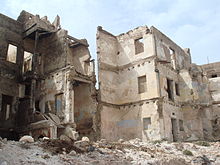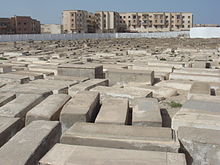- Moroccan Jews
-
Moroccan Jews, יהדות מרוקו , يهود مغاربة
Shlomo Ben Ami • Amir Peretz • David Levy • Meir Sheetrit • Ronit Elkabetz • Ninet Tayeb • Gad Elmaleh • Edmond Amran El Maleh • Emanuelle Chriqui Languages Hebrew, Moroccan Arabic, Judeo-Moroccan Arabic, Berber, Judeo-Berber, French, Spanish.
Religion Related ethnic groups Moroccan Jews are thought to have two main origins, the first being Jewish migration to North Africa during and after the Second Temple period. A second large wave of migration from the Iberian peninsula occurred in the period leading up to the Alhambra Decree in 1492. Over the following five centuries, most of the differences between Jews of different migrations were lost. Prior to the mass exodus of Jews between 1948 and 1967, Morocco had a Jewish population of more than 250,000. Today, Jews of Moroccan descent can be found all over the world, but mainly in Israel (around 1 million), France, Canada, United States and Venezuela. Fewer than 5,000 Jews remain in Morocco itself.
Moroccan Jews are a branch of Sephardic and Mizrahi Jews.
Contents
History
Main article: History of the Jews in MoroccoMoroccan Jews constitute an ancient community, immigrating to the region as early as 70 CE. Until the 1950s the majority of Morocco's Jews were still living in Morocco. In accordance with the norms of Islamic legal system, Jewish Moroccans had separate legal courts pertaining to "personal law" under which communities (Muslim sharia, Christian Canon law and Jewish halakha law abiding) were allowed to rule themselves under their own system. After Israel's independence in 1948, and due to domestic strife in the 1950s, the next several decades saw waves of Jewish emigration to Israel, France and Canada.
French and Spanish Influences
As a protectorate of France, parts of Morocco were heavily influenced by French culture, while the same is true of the portions of the country that belonged to Spain. Traditionally, the Jews were classified as being French-Moroccan or Spanish-Moroccan depending on where in Morocco they lived, and remnants of these classifications can be felt today. These differences are reflected in language, foods, last names and even liturgy[citation needed].
Communities Today
 Old Jewish quarters in Essaouira.
Old Jewish quarters in Essaouira.
 Jewish cemetery in Essaouira.
Jewish cemetery in Essaouira.
Morocco
In 2003 It was estimated that 5,000 Jews still lived in Morocco, mainly in Casablanca.[1] Other towns are said to have smaller, aging populations.Israel
The 1950s saw large waves of Jewish emigration from Morocco to Israel. Many Moroccan Jews were transferred to peripheral development towns while others settled in larger, established cities. Today, Jews of Moroccan descent can be found all across Israel.France
Popular communities in France include Paris, Marseille, Strasbourg, Lyon and Nice.Argentina
Mainly in Buenos Aires and Rosario.Canada
In the 1950s Canada began extending visas to Jews from Morocco. Large communities developed in Montreal andToronto. Moroccans were attracted to Canada because of its high quality of life and to Montreal in particular because of the French language. Toronto is known for its significant Spanish-Moroccan population originating from cities such as Tangiers and Tetouan. In recent past, however, an emergence of French-Moroccan musical liturgy and customs has been noticed even in this dominant-Spanish Moroccan city. For example, the traditional Moroccan Bakashot, classical music sung by Sephardic Jews in the winter months across countries in the Middle East on Friday night, has come to life in recent productions by Magen David Congregation and Abir Ya'akob Congregation.[citation needed]Venezuela
Concentrated mainly in Caracas.Culture
Moroccan Jewry has developed as a hybrid of the many cultures that have shaped Morocco itself, namely Jewish, French, Spanish, and Arab.
Henna
Traditional Henna parties usually take place within the week before a special occasion, such as a wedding, Bar/Bat Miṣva, or baby showers. During pre-wedding Henna parties, the oldest member of the family (often the grandmother) smudges henna in the palm of the bride and groom to symbolically bestow the new couple with good health, fertility, wisdom, and security. The henna is believed in Moroccan tradition to protect the couple from demons.
The grandmother covers the henna, a dough-like paste produced by mixing crushed henna plant leaves with water, in order to lock in body heat and generate a richer color. Normally, the henna will dye skin orange for up to 2 weeks. In Moroccan folklore, the bride is exempt of her household duties until the henna completely fades. After the bride and groom are blessed with the henna, the guests also spread henna on their palms to bring good luck.
Clothing
Although most Moroccan Jews tend to dress in styles of their adopted countries, traditional Moroccan clothing is sometimes worn during celebrations (Mimouna, weddings, Bar Miṣvas, etc.) or even during more intimate gatherings, such as Shabbat dinner. Men usually wear a white jellaba (jellabiya) cloak while women wear more ornate kaftans.
Mimouna
Mimouna is celebrated by many Moroccan Jews on the night following the last day of Passover. It has spread to be an almost national holiday in Israel.
Religious Observance
Moroccan Jews are a historically religious people. Many Rabanim have passed through and sojourned in Morocco leaving behind their great influence. In 2008, a project to preserve Moroccan Torah and the words of its Ḥakhamim was initiated. DarkeAbotenou.com was created by a few members of the Toronto Sephardic Community; devoting their time and effort to increasing global awareness of the customs and laws that Jews of Morocco live with everyday. Daily emails are sent in both English and French containing the customs, laws, and traditional liturgy of both the French and Spanish parts of Morocco. This daily publication is currently broadcasted in both English and French.[2]
Liturgy
The observer of a typical Moroccan Jewish prayer service will note the presence of Oriental motifs in the melodies. However, unlike the tunes of Eastern rites (Syrian, Iraqi, etc.), which were influenced by Middle Eastern sounds, Moroccan Jewish religious tunes have a uniquely Andalusian feel. Furthermore, just as Eastern liturgical melodies are organized into Maqams, Moroccan liturgy can be classified by Noubas.
The Moroccan prayer rite itself is also unique among Sephardic customs. The Moroccan nusach has many unique components but has also incorporated numerous Ashkenazic customs due to the country's proximity and exposure to Europe. Some customs of the Moroccan nusach include:
- Two blessing for Hallel: One blessing (ligmor et ha'Hallel) is said when the full Hallel is recited, while the other blessing (likro et ha'Hallel) is said when the abridged Hallel is recited. Other Sephardim omit the latter.
- Yiru Enenu: The blessing commencing with the words Yiru Enenu (translation: Our eyes shall see) is recited after Hashkivenu in the Arvit service after the Sabbath. Many Ashkenazim say this passage on every weekday night after Hashkivenu. This custom is discussed in Tosafot of Tractate Berakhot 4a.
- Pesukei Dezimra: The opening verse of Psalm 30 ("Mizmor Shir Ḥanukat Habayit LeDavid") is added to the remainder of the Psalm during Shaḥarit of Hanuka. Other Sepharadim begin with "Aromimkha" even on Ḥanuka.
- Shir HaShirim: This is usually read between Minha and Kabbalat Shabbat on the Sabbath eve. Other Sephardic groups tend to read it before Minḥa. Moroccan Jews chant Shir HaShirim with a unique cantillation. A common practice is for a different congregant to sing each chapter.
- Before the repetition of the Amidah in Shaḥarit and Musaf of Rosh Hashana and Yom Kippur, the hymn "Hashem sham'ati shim'akha yareti" (Translation: Hashem, I have heard your speech and was afraid) is sung. The origin of this verse is Habakkuk 3:2.
Religious Customs
- Many Moroccan synagogues read from an Ashkenazi-style Torah scroll, rather than the stand-up Torah scroll used by other Sepharadim.
- Psalm 29 and Lekha Dodi are recited sitting down in the Kabbalat Shabbat service.
- Packets of salt are distributed to congregants on the second night of Passover, marking the first counting of the 'Omer. The significance of salt includes the commemoration of the sacrifices in the Temple and other Kabbalistic reasons.[3]
- Pirke Avot is read during the Musaf service of Shabbat between Passover and Shavuot. As well, the custom is for pre-Bar Miṣva boys to read each chapter, and this is usually performed with a special tune.
- After reciting the Moṣi blessing over bread, there is a custom to dip the bread into salt while reciting "Hashem melekh, Hashem malakh, Hashem yimlokh le'olam va'ed" (Translation: God reigns; God has reigned; God will reign for ever and ever). This "verse" is actually a compilation of 3 verses taken from Psalms and Exodus. The validity of this custom has been disputed among Moroccan Poskim since it may constitute an interruption of a blessing.
- Before the Magid section of the Passover Seder, the Seder plate is raised and passed over the heads of those present while reciting "Bibhilu yaṣanu mi–miṣrayim, halaḥma 'anya bené ḥorin" (Translation: In haste we went out of Egypt [with our] bread of affliction, [now we are] free people). It can be heard here.[4]
Notable Moroccan Jews
- André Azoulay, senior adviser to King Mohammed VI of Morocco
- Abraham Serfaty, former Moroccan communist leader and opponent to King Hassan II
- Gad Elmaleh, comedian and humorist
- Paul Marciano, fashion designer and co-founder of Guess? Inc.
- Rabbi Shlomo Moshe Amar, Sephardi Chief Rabbi of Israel and Rishon LeZion
- Richard Attias, Executive Chairman of the Experience Corporation
- Zehava Ben, singer
- Michele Bohbot, fashion designer and retailer
- Emmanuelle Chriqui, actress
- Shiri Maimon, Israeli singer who represented Israel in the 2005 Eurovision Song Contest, placing 4th in the finals.
- André Elbaz, painter and filmmaker
- Maguy Kakon, author, politician and real-estate consultant
- Edmond Amran El Maleh, writer
- Reuven Abergel, founder of the "Israeli Black Panthers"
- Haim Zafrani, scholar and writer
- David Guetta, French DJ of Moroccan descent
- Alber Elbaz,Israeli fashion designer.
- Yossi Benayoun,Israeli professional footballer who currently plays for Chelsea.
- Yoshiyahu Yosef Pinto,Israeli Jewish spiritual leader and Kabbalist who lives in New York City.
- Ronit Elkabetz , Israeli Jewish actress and filmmaker.
- Elena Benarroch, Spanish fashion designer born in Tangier.
- Samuel Hadida, Moroccan international film producer and co-founded the company Metropolitan Filmexport.
- Daniel Benlulu, Israeli Moroccan-born politician.
- Michel Abitbol, Moroccan research fellow at the Hebrew University of Jerusalem.
- Khleo Thomas, American actor and rapper. Mother born in Morocco.[5]
- Ralph de Toledano, American figure in the conservative movement in the United States.
References
- ^ "Jews of Morocco", Jewish Library.
- ^ Darké Abotenou » About. Darkeabotenou.com (2008-11-21). Retrieved on 2011-07-04.
- ^ "Salt of Omer" in the Kehila Centre Website. (PDF) . Retrieved on 2011-07-04.
- ^ Pesah פסח – Bibhilou בבהילו – Jo 'Amar ג'ו עמר z"l. YouTube. Retrieved on 2011-07-04.
- ^ Pfefferman, Naomi. (2003-04-17)Digging For Jews | Arts. Jewish Journal. Retrieved on 2011-07-04.
- Treasury of Sephardic Laws and Customs, Herbert Dobrnisky, Yeshiva University Press 1996
- David Bensoussan, Il était une fois le Maroc : témoignages du passé judéo-marocain, éd. du Lys, www.editionsdulys.com, Montréal, 2010 (ISBN 2-922505-14-6)
External links
Categories:- Jewish ethnic groups
- Moroccan Jews
- Mizrahi Jews topics
- Sephardi Jews topics
Wikimedia Foundation. 2010.










